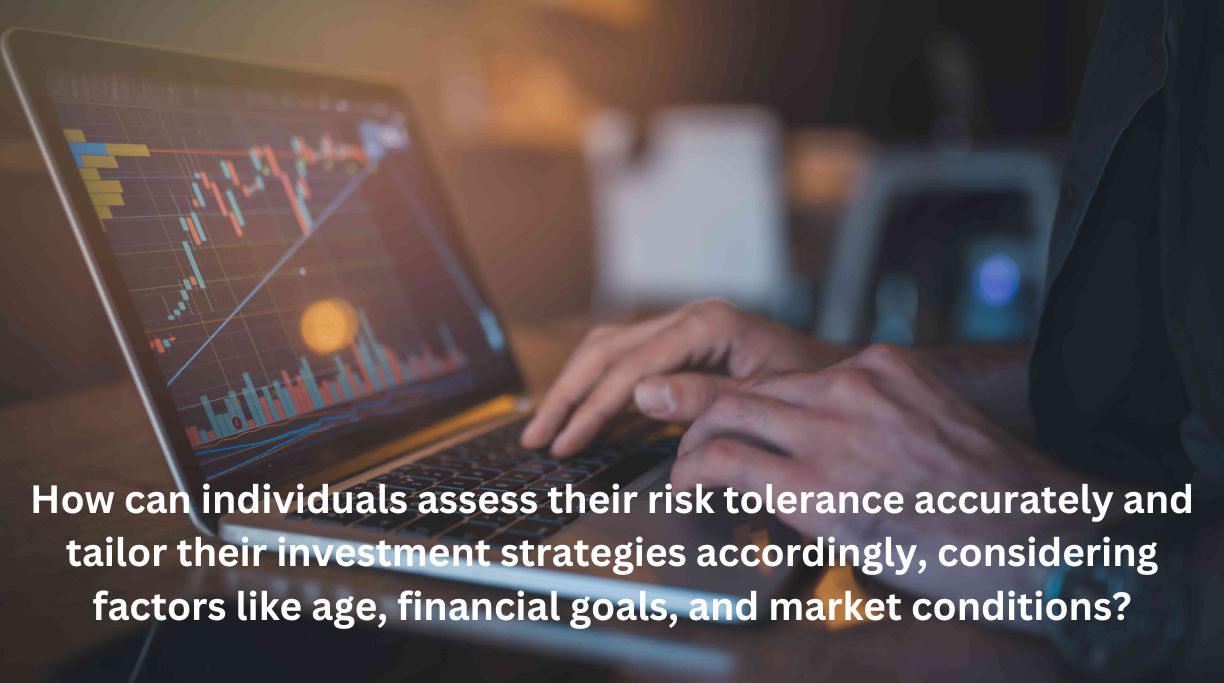Financial market investing may be thrilling and intimidating at the same time. Knowing how much risk you can tolerate and adjusting your investing techniques accordingly are the keys to success. This post will discuss how people can accurately determine their level of risk tolerance and make well-informed decisions depending on their age, their financial objectives, and the state of the market.
What Age Is a Crucial Determinant?
Younger Projects
People typically discover that they have a greater risk tolerance in their early adult years. Since they have more time on their side, young investors can afford to take on bigger risks. They can withstand market swings and profit from return compounding with a longer investment horizon. Investing in high-risk, high-reward assets like equities or start-ups at this era can be tactically advantageous. The possibility of significant returns is greater than the volatility in the short run, which is consistent with the long-term objectives of wealth creation.
Mid-Life Equilibrium Act
People’s priorities change as they approach the middle phases of their work and family lives, and their risk tolerance typically changes with them. Preserving and stabilizing wealth frequently becomes the main priority. Risk management becomes essential to safeguarding collected wealth. During this era, diversification is essential. Risks can be reduced by spreading assets throughout a variety of asset classes, such as bonds, stocks, and real estate. The aim is to keep a balance that protects against market downturns and is in line with financial objectives.
Golden Era
Reevaluating risk tolerance is necessary when one approaches retirement or the golden years. Growth becomes less of a priority in favor of capital protection. People who have a shorter time horizon are less likely to tolerate market volatility, which could negatively affect their retirement savings. At this point, it’s usually advised to take a more cautious approach to investing and concentrate on dependable assets like bonds and dividend-paying equities. The goal is to guarantee a consistent income stream in retirement and safeguard the capital amassed over a career.
Read Also:
- What role does diversification play in building a resilient investment portfolio, particularly in the stock market?
- In the context of finance, how do geopolitical events influence investment strategies, and what precautions should investors take to mitigate potential risks?
- How can one strike a balance between conservative and aggressive investment strategies to align with their risk tolerance and financial goals?
- What role do environmental, social, and governance (ESG) factors play in shaping responsible and sustainable investment strategies?
- In the current economic climate, what adjustments should investors make to their finance strategies to navigate uncertainties and market volatility?
What is Risk Tolerance and Financial Goals?
Success through Strategic Alignment
Investors need to be very clear about their financial objectives before diving into the intricacies of risk tolerance. These objectives serve as guiding lights, directing investment plans toward particular results like home ownership, college funding, or a comfortable retirement. A strong investment plan starts with these objectives being in line with risk tolerance.
Case Studies: Getting Around the Investment Environment
Case Study 1: The Path to Homeownership
Think about Sarah, a young professional who wants to purchase her first house in ten years. Given her extended time horizon and somewhat elevated risk tolerance, she chooses a diversified portfolio that includes a sizeable portion of growth-oriented assets. Optimizing returns and expediting her savings for the down payment are the goals.
Case Study 2: Precise Financing for Education
John is a dad who shows a moderate risk tolerance and is making plans for his child’s schooling. His financial objective is to save enough money for college tuition in a predetermined amount of time. In order to generate consistent gain while reducing potential losses, a balanced investing strategy consisting of a mix of stocks and bonds is used in this instance.
Case Study 3: Safety in Retirement
James, who is getting close to retirement, would rather preserve funds than pursue rapid expansion. His investing portfolio is more heavily weighted toward conservative assets like dividend-paying equities and bonds due to his reduced risk tolerance. This strategy seeks to protect his wealth accumulation and provide a steady flow of income in retirement.
What is Risk Tolerance and Financial Goals?
Strategic Alignment of Objectives and Tolerance for Risk
Clearly defining your financial goals is crucial before delving into the nuances of risk tolerance. Your goals are the foundation of your investment strategy, whether they be to buy a house, pay for your child’s school, or ensure a happy retirement. It is critical to comprehend the time range and urgency of these objectives.
Case Studies: Dreams Come True with Careful Investing
Case Study1: Quickening the Acquisition of a Home
Introducing Emily, a young professional who wants to acquire a home within the next ten years and has a high risk tolerance. Her approach to investing is centered on seizing chances for long-term growth. In an effort to optimize returns and expedite her house-buying process, Emily favors a diverse portfolio that includes a sizeable portion of stocks.
Case Study 2: Precisely Financing Education
Take David, a dad who wants to save money for his child’s school but has a modest risk tolerance. David diversifies his investments by using a balanced approach that alternates between stocks and bonds. This strategy aims to minimize possible losses while achieving consistent progress, guaranteeing that his child’s academic goals are satisfied without jeopardizing the family’s financial stability.
Case Study 3: Achieving Happiness in Retirement
Let’s now examine Sandra, who is almost ready to retire. Her priorities change from aggressive growth to wealth preservation and income generation as a result of her decreased risk tolerance. Sandra chooses a conservative investment strategy, gravitating toward dependable stocks and bonds. Her collected money will be protected thanks to this calculated move, giving her a steady source of income when she retires.
What is risk Assessment and Market Conditions?
Commercial Patterns
Recognizing Market Dynamics: The state of the market is influenced by a wide range of factors, such as technological developments, geopolitical events, and economic indicators. These elements affect investor sentiment, which in turn affects risk tolerance.
Effect on Risk Tolerance: Investors frequently show a higher risk tolerance and a tendency toward more aggressive investment techniques in positive markets, where optimism is prevalent. On the other hand, risk aversion typically increases in negative markets that are typified by pessimism, leading to a move towards more conservative strategies.
Flexible Approaches
Bullish Markets: Adaptive methods may involve taking advantage of high-return, high-risk possibilities during times of economic expansion and rising markets. Higher risk-tolerant investors may decide to devote more of their portfolio to growth-oriented companies and assets in order to optimize returns in periods of strong market performance.
Bearish Markets: Stability and capital preservation become more important during market downturns. Investors may reallocate their portfolios to safer assets like defensive stocks and bonds after reassessing their risk tolerance. The goal of this adaptive method is to reduce losses in periods of volatile markets.
Sideways Markets: Diversification becomes an effective strategy in markets that are displaying sideways trends or more volatility. Investing across a range of businesses, asset classes, and geographical areas helps reduce the risk of particular market fluctuations. The goal of this flexible approach is to build a well-rounded portfolio that can withstand market volatility.
Conclusion
Developing a sophisticated awareness of market dynamics, financial objectives, and life stages is essential to perfecting the skill of matching investment strategies with risk tolerance. Instead of avoiding risk, one should proactively embrace it in light of constantly shifting conditions. Adaptive techniques designed to market movements enable investors to confidently traverse both highs and lows as the financial landscape changes. Recall that in this ever-changing voyage, adaptability and wise decision-making are your constant allies, guaranteeing that your investments not only survive the storms but also prosper in the shifting market conditions.
FAQs
- Q: How often should I reassess my risk tolerance?
- A: Regular reassessment is crucial, especially during significant life changes or market shifts. Aim to review your risk tolerance annually or when there are substantial shifts in your financial circumstances.
- Q: Can risk tolerance change over time?
- A: Absolutely. Factors like age, financial goals, and market experiences can influence your risk tolerance. It’s essential to reassess periodically to ensure your investment strategy aligns with your current mindset and circumstances.
- Q: How do I determine my risk tolerance accurately?
- A: Utilize reputable risk assessment tools, consult with financial advisors, and reflect on your emotional response to financial fluctuations. A comprehensive approach ensures a more accurate understanding of your risk tolerance.
- Q: What role do emotions play in risk assessment?
- A: Emotions can significantly impact decision-making. Recognizing and managing emotions is crucial for maintaining a balanced and rational approach to risk assessment. Emotional intelligence is an asset in the world of investing.
- Q: Is it advisable to time the market based on risk tolerance?
- A: Timing the market is challenging and often unreliable. Instead of trying to predict market movements, focus on a well-diversified portfolio aligned with your risk tolerance and long-term financial goals.








